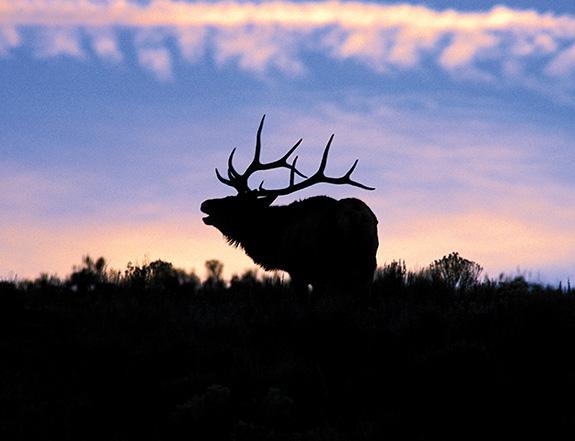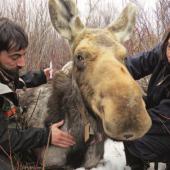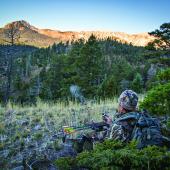Second Best
Hunting the rifle-season rut.
It was opening week of the general rifle season. My hunting party slowly worked its way up a backwoods trail toward a large meadow for a late-afternoon hunt. The wind was still, the temperature pleasant, but the slight aroma of oncoming moisture filled the air as we neared our destination. One last break in the terrain stood between the meadow and us. We paused as a light fog of snowflakes rolled in over the lodgepole. The snow fell straight down, accentuating the calm. Suddenly, the shrill of a bugle broke the serenity.
As elk hunters, we often neglect the rut after setting down our bows and picking up our rifles. Science dictates that the elk rut begins on a certain date and ends about two weeks later. September 15 is that magical day which most profess signals the start of the first estrous cycle. This is a magical time to hunt elk.
As a hunting guide with a lifetime of field experience, I concur with this scientific assessment; however, through the years I have seen many variations to this schedule. In deep-snow country the elk tend to enter the rut a bit later than projected. In some lower-elevation areas, the first estrous seems to kick in earlier. Experience indicates that the rut directly corresponds to the spring calving season, and hence, Mother Nature provides for the optimal calf-survival rate by offsetting the rut to accommodate varying climates and conditions.
Like all ungulates, the elk rut consists of two estrous cycles that can be broken down into varying phases of elk activity. Early September kicks off the pre-rut period. Bulls old and young swell as their bodies release hormones essential to the upcoming rut. Bull elk have a naiveté during the pre-rut and tend to respond to calls more out of curiosity than purpose. Strategic hunters can successfully use both bugles and cow calls to lure bulls within range of their bows.
Next comes the first estrous cycle, the rut most hunters lay in bed dreaming about. Cows come in heat. Herd bulls spend all day and night breeding, maintaining their harems and fighting off the ever-present threat of satellite bulls. The first estrous period is exciting as days are filled with chasing, calling, and numerous encounters. Opportunities seem endless, but satellite bulls provide most of the action.
As the first estrous cycle winds down, the herd bulls, weary from weeks of maintaining their harems, take leave of their cows for a well-deserved rest. The younger bulls, once satellites, break the cows into smaller herds. It’s common to see a first-year 5x5 running with half-a-dozen cows or a raghorn bull pretending to be a king with his three cows during this brief intermission.
For some, this is the conclusion of archery season. For seasoned guides and hunters, it’s a chance at the true trophies. The herd bulls that opted for rest during the rut’s intermission aren’t through. Mature herd bulls transform into satellites as the cows that weren’t successfully bred during the primary estrous period come back into heat for the second estrous period.
Activity and elk vocalization during the second estrous is not as hot and heavy. However, the herd bulls that have repeatedly pushed their cows off when challenged by a hunter’s bugle, now exhausted from a month of pre-rut and rutting activities, tend to let their guard down. Mature bulls respond with authority and approach aggressively when they hear calling which indicates that a cow is in season. They break from the concealment of the dark timber and put on massive displays of dominance, growling, chuckling, raking, and trotting back and forth in the center of the meadows. These displays of supremacy are intended to clearly illustrate to the pretenders with their small harems exactly who is in charge, but they also create an unparalleled opportunity for a knowledgeable archer to harvest the bull of a lifetime.
These late-season archery hunts aren’t top priority for most hunters. The thrill and exaggerated activity of the first estrous cycle draw the most participation; however, it is that same draw that provides additional benefits to second-estrous hunting. The reduction in hunting pressure puts the elk at ease. Bulls who may have become call-shy from an excess of human foot traffic early in the season tend to relax and respond accordingly once again.
It is in these early weeks of the general rifle season that I have experienced some of my most memorable elk encounters. With the inherent knowledge of an ongoing estrous cycle, and a properly placed bugle, I have called mature bulls as close as 15 yards. I have watched entire mountainsides come alive with activity from a single estrous whine and have even had entire herds charge straight at me after a misplaced shot followed by a strong lead cow call.
Back in the meadow, snow continued to fall and the fog thickened. Devoid of even the slightest movement and suddenly accompanied by deafening silence, I reached for my bugle and awoke the monarch. The bull responded instantaneously from a patch of timber 200 yards out. Cows began to filter through the treeline toward our location, but the bull hesitated. I chuckled, establishing my dominance as the cows came nearer, and then he emerged. Unlike the cows, he didn’t run right into the meadow, but rather held tight to the timber as he answered my challenge with a deep-throated chuckle.
A single shot echoed from the surrounding mountain peaks.











